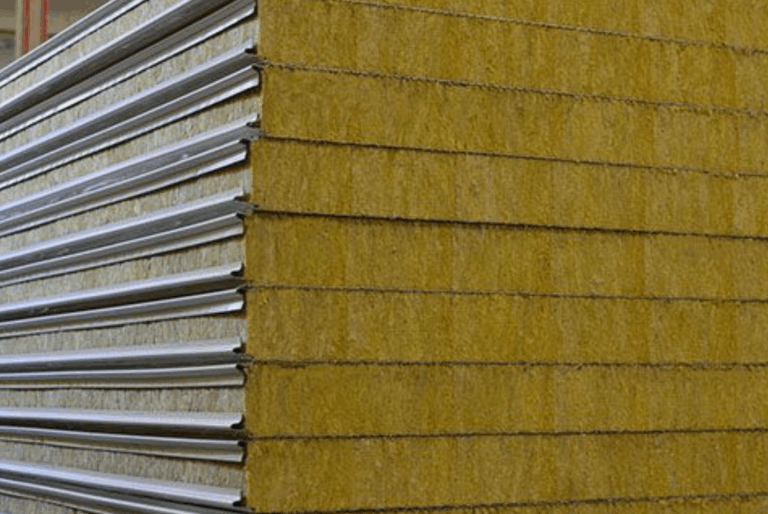Insulated sandwich panels with a rock wool core are ideal construction elements for fire-retardant enclosures.
Due to their characteristics and performance, rock wool sandwich panels are integrated into the construction of commercial and industrial buildings, for both vertical partitions and roofs, as well as internal divisions. Rock wool sandwich panels also serve to insulate specific spaces, such as boiler rooms, garages, or warehouses with hazardous substances.
Rock wool panels stand out for their ease of installation and performance compared to other more complex and costly fire protection systems.
Ignition-resistant characteristics of rock wool sandwich panels
The sandwich panel consists of an insulating core made of rock wool, responsible for fire resistance, protected by two steel sheets that provide structural strength. The mineral wool core of the sandwich panels has a Euroclass A1 classification, according to the European standard EN 13501-1.
The standardized Euroclass system of the European Union subjects construction elements and materials, such as rock wool, to tests and rates their behavior in fire situations. The test results allow products to be classified into one of the seven fire protection Euroclasses: A1, A2, B, C, D, E, and F.
The first three Euroclasses (A1, A2, and B) encompass the safest construction products in terms of fire behavior, due to their non-combustible or low combustibility nature. The maximum classification of rock wool panels means that the material, being inorganic, does not participate in combustion, nor does it generate smoke or drip, a fundamental characteristic in roof sandwich panels.
McMillan’s rock wool panels have Euroclass classifications such as: A2-s1, d0. For modular systems of cellular polycarbonate McMillan’s, for roofs and vertical partitions, the Euroclass classification is: B-s1, d0. The sandwich panels resist fire for a certain period, depending on the thickness, without losing structural properties. For example, a rock wool panel with an 80 mm thickness withstands fire for one hour, and with 100 mm thickness, the resistance reaches two hours. Such is the case of McMillan’s 5-rib roof panels, whose mechanical resistance allows them to cover large spans and withstand, depending on the configuration, up to 120 minutes of fire exposure (EI120).
Advantages of Installing Sandwich Panels
Sandwich panels consist of two rigid material sheets protecting a rock wool insulating core. Panels integrated into enclosures offer, at a reasonable price, great resistance to impacts and weather phenomena, and long-lasting performance with minimal maintenance. Sandwich panels are available with different finishes and configurations to enhance specific specifications, such as thermal and acoustic insulation.
Sandwich panels provide significant economic advantages compared to other construction systems because they are assembled dry. Dry assembly means that the building is not constructed traditionally with heavy machinery, water, cement, and electricity expenses, but rather prefabricated elements are assembled with mechanical joints, such as bolts and screws.
Panel installation provides high resistance to earthquakes, a factor to consider in EEUU: the system’s weight is lower than that of other construction methods, and the structure is lighter.
Rock wool panels easily adapt to the characteristics of each project, both in technical specifications and aesthetic finish. In the case of sandwich panels, assembly systems, such as tongue and groove, facilitate the work of operators and reduce the building’s delivery time. The system ensures efficient sealing, eliminates the risk of infiltration, and increases the effectiveness of thermal and acoustic insulation. Dry assembly is scalable. Construction with sandwich panels is easier to expand or modify. Assembling an entire building with sandwich panels, or any construction element thereof, is executed quickly and with the right machinery, saving time and costs.





